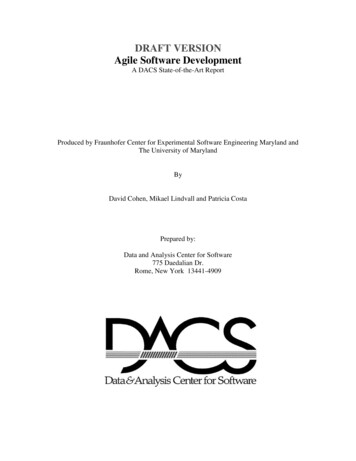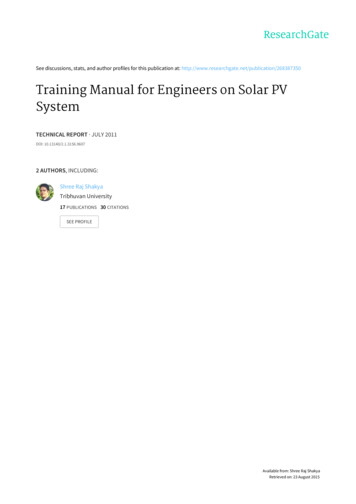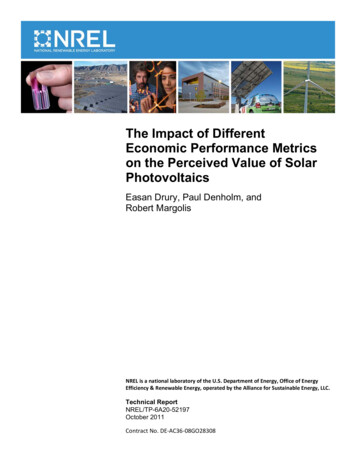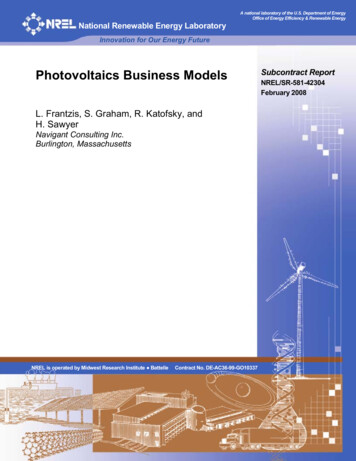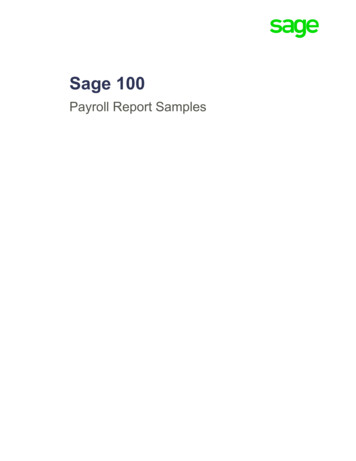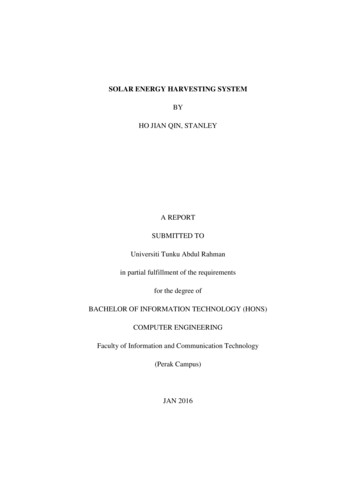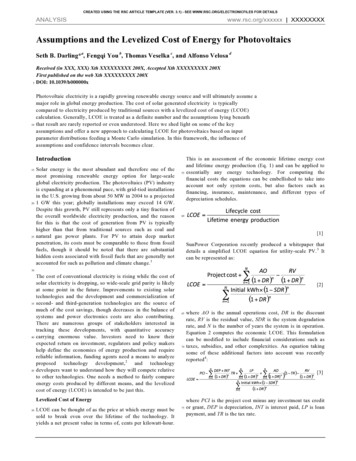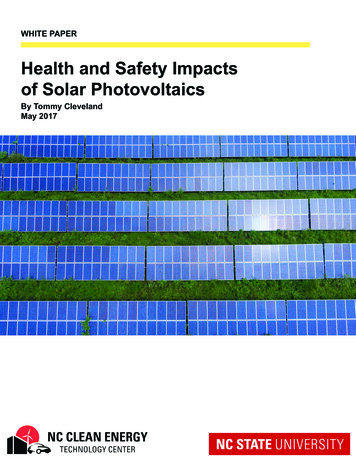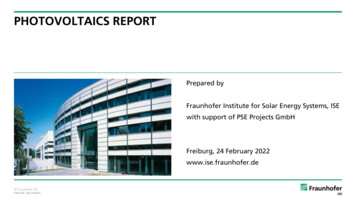
Transcription
PHOTOVOLTAICS REPORTPrepared byFraunhofer Institute for Solar Energy Systems, ISEwith support of PSE Projects GmbHFreiburg, 24 February 2022www.ise.fraunhofer.de Fraunhofer ISE/Foto: Guido Kirsch Fraunhofer ISEFHG-SK: ISE-PUBLIC
CONTENT Quick Facts Topics: PV Market Solar Cells / Modules / System Efficiency Energy Return of Invest (EROI) & Energy Payback Time (EPBT) Inverters Price Development Abbreviations Further Studies and Analyses Acknowledgements2 Fraunhofer ISEFHG-SK: ISE-PUBLIC
IntroductionPreliminary Remarks The intention of this presentation is to provide up-to-date information. However, facts and figureschange rapidly, and the given information may soon be outdated again. This work has been carried out under the responsibility of Dr. Simon Philipps (Fraunhofer ISE) andWerner Warmuth (PSE Projects GmbH). Price indications are always to be understood as nominal, unless this is stated explicitly. For example,prices in the learning curves are inflation adjusted. The slides have been made as accurate as possible and we would be grateful to receive any commentsor suggestions for improvement.Please send your feedback to simon.philipps@ise.fraunhofer.de and also to warmuth@pse-projects.de Please quote the information presented in these slides as follows: Fraunhofer ISE: Photovoltaics Report, updated: 24 February 20223 Fraunhofer ISEFHG-SK: ISE-PUBLIC
Quick FactsParameterValueStatusReferenceDate of dataGerm any / EU27 / Worldw idePV market4.9 / 18.2 / 144 GW5.3 / 26 / 183 GWEnd of 2020End of 2021*BNA / SPE / BNEFBNA / SPE / BNEF11/2021; 12/2020; 02/202202/2022; 02/2022; 02/2022Cumulative installation54.0 / 138.2 / 710 GWEnd of 2020ISE / SPE / IRENA11/2021; 07/2021; 09/2021PV power generation47.7net / 145.9gross / 855.7gross TWh2020ISE / BP / BP10/2021; 07/2021; 07/2021PV electricity share9.9%net / 5.3%gross / 3.2%gross2020ISE / BP / BP12/2021; 07/2021; 07/2021Worldw idec-Si share of production95%2020IHS Markit05/2021Record solar cell efficiency: III-V MJ(conc.) / mono-Si / CIGS / multi-Si /CdTe47.1 / 26.7 / 23.4 / 24.4 / 21.0%06/2021Green et al.06/202111/2021Germ anyPrice PV rooftop system1,050 to 1,850 /kWpEnd of 2021BSWLCOE PV power plant3.1 to 5.7 ct / kWh2021ISELowest/Latest PV-Tender Price4.33/5.00 ct / kWh02/2018;11/2021BNA4 Fraunhofer ISEFHG-SK: ISE-PUBLIC*preliminary estimates11/2021
Executive SummaryPV Market: Global Photovoltaics is a fast-growing market: The Compound Annual Growth Rate (CAGR) of cumulativePV installations including off-grid was 34% between year 2010 to 2020. In 2020 producers from Asia count for 95% of total c-Si PV module production. China (mainland)holds the lead with a share of 67%. Europe contributed with a share of 3%; USA/CAN with 2%. Wafer size increased and by keeping the number of cells larger PV module sizes are realized allowinga power range beyond 600 W per module. In 2020, Europe’s contribution to the total cumulative PV installations amounted to 22% (comparedto 24% in 2019). In contrast, installations in China accounted for 33% (same value as the year before). Si-wafer based PV technology accounted for about 95% of the total production in 2020. The share ofmono-crystalline technology is now about 84% (compared to 66% in 2019) of total c-Si production. Market shifts from subsidy driven to competitive pricing model (Power Purchase Agreements PPA).5 Fraunhofer ISEFHG-SK: ISE-PUBLIC
Executive SummaryPV Market: Focus Germany In year 2020, Germany accounted for about 7.6% (53.6 GWp) of the cumulative PV capacity installedworldwide(707.5 GWp) with about 2 million PV systems installed in Germany. In 2021 the newly installedcapacity in Germany was 5.3 GWp; in 2020 it was 4.6 GWp. PV covered 9.9% of Germany’s net electricity generation in 2021 while all Renewable sourcesdelivered about 45.9%. In 2020 about 35 Mio. t CO2 equivalent GHG emissions have been avoided due to 50.6 TWhelectrical energy generated by PV in Germany. PV system performance has strongly improved. Before 2000 the typical Performance Ratio was about70%, while today it is in the range of 80% to 90%.6 Fraunhofer ISEFHG-SK: ISE-PUBLIC
Executive SummarySolar Cell / Module Efficiencies The record lab cell efficiency is 26.7% for mono-crystalline and 24.4% for multi-crystalline siliconwafer-based technology. The highest lab efficiency in thin film technology is 23.4% for CIGS and21.0% for CdTe solar cells. Record lab cell efficiency for Perovskite is 25.5%. In the last 10 years, the efficiency of average commercial wafer-based silicon modules increased fromabout 15% to 20% and more. At the same time, CdTe module efficiency increased from 9% to 19%. In the laboratory, best performing modules are based on mono-crystalline silicon with 24.4%efficiency. Record efficiencies demonstrate the potential for further efficiency increases at theproduction level. In the laboratory, high concentration multi-junction solar cells achieve an efficiency of up to 47.1%today. With concentrator technology, module efficiencies of up to 38.9% have been reached.7 Fraunhofer ISEFHG-SK: ISE-PUBLIC
Executive SummaryEnergy Payback Time Material usage for silicon cells has been reduced significantly during the last 16 years from around16 g/Wp to about 3 g/Wp due to increased efficiencies, thinner wafers and diamond wire sawing aswell as larger ingots. The Energy Payback Time of PV systems is dependent on the geographical location: PV systems inNorthern Europe need around 1.2 years to balance the input energy, while PV systems in the Southequal their energy input after 1 year and less, depending on the technology installed and the gridefficiency. A PV system located in Sicily with wafer-based Silicon modules has an Energy Payback Time of aroundone year. Assuming 20 years lifespan, this kind of system can produce twenty times the energyneeded to produce it.8 Fraunhofer ISEFHG-SK: ISE-PUBLIC
Executive SummaryInverters Inverter efficiency for state-of-the art brand products is 98% and higher. The market share of string inverters is estimated to be 64%. These inverters are mostly used inresidential, small and medium commercial applications in PV systems up to 150 kWp. The marketshare of central inverters, with applications mostly in large commercial and utility-scale systems, isabout 34%.A small proportion of the market (about 1%) belongs to micro-inverters (used on the module level).The market share for DC / DC converters, also called “power optimizers”, is estimated to be 5% ofthe total inverter market. Trends: Digitalisation, Repowering, new features for grid stabilization and optimization of selfconsumption; storage; utilization of innovative semiconductors (SiC or GaN) which allow very highefficiencies and compact designs; 1500 V maximum DC string voltage.9 Fraunhofer ISEFHG-SK: ISE-PUBLIC
Executive SummaryPrice Development In Germany prices for a typical 10 to 100 kWp PV rooftop-system were around 14,000 /kWp in 1990.At the end of 2020, such systems cost only 7.4% of the price in 1990. This is a net-price regression ofabout 92% over a period of 30 years. The Experience Curve – also called Learning Curve - shows that in the last 40 years the module pricedecreased by 26% with each doubling of the cumulated global module production. Cost reductionresults from economies of scale and technological improvements.10 Fraunhofer ISEFHG-SK: ISE-PUBLIC
1. PV Market By region By technology11 Fraunhofer ISEFHG-SK: ISE-PUBLIC
PV Module Production by Region 1990-2020Percentage of Total MWp Produced Fraunhofer ISEData: Up to 2004 Strategies Unlimited; 2005 to 2009: Navigant Consulting; since 2010: IHS Markit. Graph: PSE 202112 Fraunhofer ISEFHG-SK: ISE-PUBLIC
PV Module Production by RegionGlobal Annual Production Fraunhofer ISEData: IHS Markit 2021. Graph: PSE 2021; Date of data: 19-May 202113 Fraunhofer ISEFHG-SK: ISE-PUBLICAbout 82% of the globalPV module has beenproduced in Asia in year2010. It increased toabout 92% of totalglobal production in year2020. China (mainland)accounted with about97 GW for 67% oftheglobalmoduleproduction in year 2020.The annual productionhas increased by a factorof 7 in this decade.
Current European c-Si PV Manufacturing LandscapeStatus Quo, End of 2020Factory sizeTotal capacitieswithin the EU [GWp/a]:Module6.75Solar cell0.65Value chain stepmg-SiPoly-SiIngot / WaferCellModuleStakksberg 1 GWppcc SE 500 MWp22.1mg-Si30.2 50 MWpNorSunIngot&Wafer 1.25Poly-Si 100 MWpELKEMNorwegian CrystalsHevel roductsSoluxtec Fraunhofer ISESunPowerRECOMSilliaVoltecEDF L Fraunhofer ISEFHG-SK: ISE-PUBLICBruk-BetKness groupWackerSolaicoData and Graph: Jochen Rentsch, Fraunhofer ISE 2021HanplastXdiscsJAHAPikCellAltius
Global Cumulative PV InstallationFrom 2010 to 2020 Fraunhofer ISEData: IRENA 2021. Graph: PSE 2021. Date of data: Apr-202115 Fraunhofer ISEFHG-SK: ISE-PUBLIC
Global Cumulative PV Installation by RegionStatus 2020The total cumulative installationsamounted to about 710 GWp at theend of year 2020.All percentages are related to globalinstalled PV capacity, including off-gridsystems. Fraunhofer ISEData: IRENA 2021. Graph: PSE 2021; Date of data: Aug-202116 Fraunhofer ISEFHG-SK: ISE-PUBLIC
Annually Installed PV System Capacity in GermanyPercentage of Annual Capacity by System Size100%The annual distributionof PV System size classesstrongly depend on: Regulations Market incentives(like EEG) Tender procedures Bankability(trust of investors)Share of Capacity Additions90%80%70%60%50%40%30%20%10%0%2000 2001 2002 2003 2004 2005 2006 2007 2008 2009 2010 2011 2012 2013 2014 2015 2016 2017 2018 2019 2020YearsRooftop 0 x 10 kWpRooftop 20 x 30 kWpRooftop 100 x 500 kWpRooftop 750 x 1000 kWp17 Fraunhofer ISEFHG-SK: ISE-PUBLICRooftop 10 x 20 kWpRooftop 30 x 100 kWpRooftop 500 x 750 kWpRooftop 1000 kWp xSource: Fraunhofer ISE, own calculationsbased on EEG-master and -flow data(netztransparenz.de, Sept. 2021)
Share of Number of PV-Systems InstalledPercentage of Cumulative Installations by System Size in Germany in 2020Total number of allgrid-connected PV-SystemsNumber of PV-Systemslarger than 500 kWpSource: Fraunhofer ISE, own calculations based on Markstammdatenregister (BNetzA;Sept. 2021)18 Fraunhofer ISEFHG-SK: ISE-PUBLICEnd of 2020 about2 million grid-connectedPV-Systems wereinstalled in Germany.
Share of Capacity of PV-Systems InstalledPercentage of Cumulative Installations by System Size in Germany in 2020PV Capacity in kWp and percentageof all grid-connected PV-SystemsPV Capacity in kWp and percentageof Systems larger than 500 kWpSource: Fraunhofer ISE, own calculation based on Markstammdatenregister and EEG-master data (netztransparenz.de, September 2021;BNetzA; September 2021)19 Fraunhofer ISEFHG-SK: ISE-PUBLICAt the end of 2020 atotalcumulatedPVcapacity of about 54 GWwasinstalledinGermany.
Electrical Capacity of Renewable Energy SourcesGermany Fraunhofer ISE Fraunhofer ISE136.8 GW of total 234.2 GW net installed electricity generation capacity in Germany were from renewable energy (RE) sources inGermany in year 2021. This results in a RE share of 58.4% of total capacity.Data: Energy Charts by Prof. Dr. Bruno Burger. Date of data: Jan-202220 Fraunhofer ISEFHG-SK: ISE-PUBLIC
PV Energy Generated and Resulting GHG Avoided EmissionsGermany Fraunhofer ISE In 2020 Greenhouse Gas emissions of about 35 Mio. t CO₂-equivalent were avoided due to 50.6 TWhPV electricity consumed in Germany.Data: BMU, BDEW, BMWi, Federal Environmental Agency (UBA) 2021. Graph: PSE 202121 Fraunhofer ISEFHG-SK: ISE-PUBLIC
Annual PV Production by TechnologyWorldwide (in GWp)About 150* GWp PV module production in 20202015Thin film2010*2020 production numbers reported bydifferent analysts vary to some extend.Different sources report a total PVmodule production between 137 and 152GWp for year 2020.Data: from 2000 to 2009: Navigant; from 2010: IHS Markit. Graph: PSE 2021. Date of data: Jun-202122 Fraunhofer ISEFHG-SK: ISE-PUBLIC2005 Fraunhofer ISE2000Mono-SiMulti-Si
PV Production by TechnologyPercentage of Global Annual ProductionProduction 2020 (GWp) Fraunhofer ISEData: from 2000 to 2009: Navigant; from 2010: IHS Markit. Graph: PSE 2021. Date of data: May-202123 Fraunhofer ISEFHG-SK: ISE-PUBLICThin film7.7Multi-Si23.3Mono-Si120.6
Market Share of Thin-Film TechnologiesPercentage of Total Global PV ProductionProduction 2020 (GWp) Fraunhofer ISEData: from 2000 to 2009: Navigant; from 2010: IHS Markit. Graph: PSE 2021 . Date of data: May-202124 Fraunhofer ISEFHG-SK: ISE-PUBLICCdTe6.1a-Si0.2CI(G)S1.5
Thin-Film TechnologiesAnnual Global PV Module Production Fraunhofer ISEData: from 2000 to 2009: Navigant; from 2010: IHS Markit. Graph: PSE 2021 . Date of data: May-202125 Fraunhofer ISEFHG-SK: ISE-PUBLIC
2. Solar Cells / Modules / System Efficiency Development in the Laboratories Development in the PV Industry Performance Ratio (PR)26 Fraunhofer ISEFHG-SK: ISE-PUBLIC
Development of Laboratory Solar Cell Efficiencies Fraunhofer ISEData: Solar Cell Efficiency Tables (Versions 1 to 59), Progress in Photovoltaics: Research and Applications, 1993-2021. Graph: Fraunhofer ISE 2021 . Date of data: Nov. 202127 Fraunhofer ISEFHG-SK: ISE-PUBLIC
Efficiency Comparison of Technologies:Best Lab Cells vs. Best Lab Modules Fraunhofer ISEData: Green et al.: Solar Cell Efficiency Tables (Version 59), Progress in PV: Research and Applications 2021. Graph: PSE 2021. Date of data: Nov. 202128 Fraunhofer ISEFHG-SK: ISE-PUBLICNote: In mass production Cell-toModule ratio (CTM) improved in pastyears by reducing losses and usingpossible gains when integrating solarcells in modules. Fraunhofer ISEprovides SmartCalc.CTM softwaresuite for the precise CTM power lossanalysis. It considers geometricallosses, optical losses & gains as well aselectrical losses.www.cell-to-module.com
Cell conversion efficiency [%]Development of Laboratory and Commercial Solar Cell EfficienciesWhat s Next?36 Fraunhofer ISE3432Physical Limit for Silicon Solar Cells30282624PERx(Lab.)2220Passivatedemitter (Lab.)18Unpassivated (Lab.)16141219501960197019801990Tandem (Lab.) Fraunhofer ISEFHG-SK: ISE-PUBLICPass.Cont. 25.5%(Com.) 24.0% PERC(Com.)26.0% 20 % Al-BSF (Com.)PassivatingContacts (Lab.)20002010Graph: Fraunhofer ISE 202129Tandem35.9 %Data: F. Stenzel et al, 36th EUPVSEC (2019), P. Altermatt, PV Cell Tech (2020)Y. Chen et al, IEEE Journal of PV 8 (2018), A. Richter et al, Nature Energy 6 (2021)M. Hermle, ETIP PV Conference, Brussels (2017)2020203020402050
Current Efficiencies and Power of Commercial PV ModulesSorted by technologyTotal weighted average efficiency of crystallineSilicon(c-Si) wafer-based modules is 20.4% in Q42021 (weighting factor is total shipments in year2020). Lowest module efficiency in this group is16.3% and highest value is 22.4%.Top 10 manufacturers represent about 78% of totalshipment volume and origin mainly in Asia.Predominant c-Si technology is mono-PERC withhalf-cut cells and Multi-Busbar.Data Source: Company product data sheets; Date of data: 04-Nov. 2021 Fraunhofer ISE30 Fraunhofer ISEFHG-SK: ISE-PUBLICNote: Selection based on modules ofTop10 manufacturers in year 2020(exception CIGS) with global availablemodule data sheets atend of Oct-2021.
Performance Ratio Development for PV SystemsGermanyIn the 1990’s Typical PR 70 % Widely ranging PR valuesToday Typical PR 83 % Fraunhofer ISESource: Fraunhofer ISE “1000 Dächer Jahresbericht“ 1994 and 1997; 2011 system evaluation, CPIA 202131 Fraunhofer ISEFHG-SK: ISE-PUBLIC Less variance in PRas compared to 1990’s
3. Energy Return of Invest (EROI) & Energy Payback Time (EPBT) Silicon usage, wafer thickness and kerf loss for c-Si EPBT: Development and comparison32 Fraunhofer ISEFHG-SK: ISE-PUBLIC
c-Si Solar Cell DevelopmentWafer Thickness [µm] & Silicon Usage [g/Wp] Fraunhofer ISEData: until 2012: EU PV Technology Platform Strategic Research Agenda, from 2012: ITRPV 2015; ISE 2016 without; 2017 to 2020 with recycling of Si. Graph: PSE Projects GmbH 202133 Fraunhofer ISEFHG-SK: ISE-PUBLIC
Historic Trend in Energy Payback TimeHarmonized Study data for mono-crystalline Silicon Rooftop PV-Systems Learning Rate:Each time the cumulative productiondoubled, the EPBT went down by 12.8 %for the last 24 years.Harmonization methodologybased on Koppelaar (2016) harmonized results and harmonization parameters1) Performance Ratiobased on average annual PV yield during lifetimePV system lifetime25Degradation0.70%PR (initial)80%PR (incl. average degradation during lifetime) 73.6%2) Grid efficiencyfor converting PV yield in primary energy equivalentsgrid efficiency35%EPBT of Leccisi (2016), Louwen (2014) and Friedrich (2020) were harmonized with1) PR (incl. average degradation) and 2) grid efficiency to results of Koppelaar (2016)*Data: Lorenz Friedrich, Fraunhofer ISE. Graph: PSE 202134 Fraunhofer ISEFHG-SK: ISE-PUBLIC* Fraunhofer ISEIrradiation: 1700 kWh/m²/a at an optimized tilt angle; Years: Estimated average year of original dataKoppelaar (2016) - Solar-PV energy payback and net energy: Meta-assessment of study quality, reproducibility, and results harmonization, Renewable and Sustainable Energy ReviewsLeccidi et al. (2016) - The Energy and Environmental Performance of Ground-Mounted Photovoltaic Systems—A Timely Update, EnergiesLouwen et al. (2014) - Life-cycle greenhouse gas emissions and energy payback time of current and prospective silicon heterojunction solar cell designs, Progress in PhotovoltaicsFriedrich et al. (2020) - Global Warming Potential and Energy Payback Time Analysis of Photovoltaic Electricity by Passivated Emitter and Rear Cell (PERC) Solar Modules, submitted JPV
Energy Pay-Back Time of Silicon PV Rooftop SystemsGeographical ComparisonIrradiation (GTI, kWh/ m²/ a)EPBT 600 Rooftop PV-system usingmono-crystalline Siliconcells* produced in China8001000 EPBT is dependent onirradiation, but also onother factors like gridefficiency**.12001.3 y ears1400 Better grid efficiency inEurope may decrease theEPBT by typically 9.5 %compared to PV modulesproduced in China.160018002000 2200Data: Lorenz Friedrich, Fraunhofer ISE. Image: JRC European Commission. Graph: PSE 2020 (Modified scale with updated data from Fraunhofer ISE)35*Cz PERC cells module with 19.9% efficiency Fraunhofer ISEFHG-SK: ISE-PUBLIC**relation between primary energy to produced electricity in the grid used for manufacturing of the PV system1.0 y ear
World Map EPBT of Silicon PV Rooftop Systems –Comparison of EPBT ChinaEPBTInfluencing factors and interpretation: EPBT: The lower, the better Irradiation: The higher, the better Grid efficiency: The higher, thebetter in countries whereupstream production is located;(better energy mix to generateelectrical power; less losses in theelectrical transmission network).At downstream (where PV isinstalled) a low grid efficiencyreduces the EPBT.EPBT Energy Pay Back Time in years: Calculated for PV-system withCz PERC 60 cells modules with 19.9 % efficiency produced in ChinaData: Lorenz Friedrich, Fraunhofer ISE. Graph: PSE 202036 Fraunhofer ISEFHG-SK: ISE-PUBLIC
Energy Pay-Back Time of Silicon PV Rooftop Systems –Comparison of EPBT China / EU, local Irradiation and Grid Efficiency Fraunhofer ISE Fraunhofer ISEEPBT for PV systems produced in Europe is shorter than for those produced in China because of better grid efficiencyin Europe.Data: Lorenz Friedrich, Fraunhofer ISE. Design: PSE 202037 Fraunhofer ISEFHG-SK: ISE-PUBLIC
4. Inverters Inverter/Converter Market38 Fraunhofer ISEFHG-SK: ISE-PUBLIC
Inverter/Converter Market 2020PowerEfficiencyString Invertersup to 150 kWpup to 98%(DC/AC)64.4% 3 - 17 -cents /Wp Easy to replaceCentral InvertersMore than 80 kWpup to 98.5%(DC/AC)33.7% 3 - 5 -cents /Wp High reliability Often sold only together withservice contractMicro-InvertersModule PowerRange90%-97%(DC/AC)1.4% 25 -cents /Wp Ease-of-replacement concernsPower OptimizerModule PowerRangeup to 99.5%(DC/DC)5.1% 8 -cents /Wp Ease-of-replacement concerns Output is DC with optimizedcurrent Still a DC / AC inverter is neededData: IHS Markit 2021; IRENA 2021. Remarks: Fraunhofer ISE 2021. Date of data: Jun-2021inverters39 Fraunhofer ISEFHG-SK: ISE-PUBLICMarketShare(Estimated)*Inverter /ConverterRemarks*Total Market Share related to shipment in MWac is greater than 100% because DC/DC converters are required to be paired with string
5. Price Development Electricity costs Market incentives in Germany Costs for PV systems Price Learning Curve40 Fraunhofer ISEFHG-SK: ISE-PUBLIC
Electricity Prices, PV Feed-In Tariffs (FIT) andbidding scheme in Germany Fraunhofer ISEData: BMU and BMWi Energiedaten 2020. Design: B. Burger - Fraunhofer ISE. Date of data: Feb.202141 Fraunhofer ISEFHG-SK: ISE-PUBLIC
PV Market Development and Incentive Schemes in Germany Fraunhofer ISE Fraunhofer ISEData: BNA. Graph: B. Burger, Fraunhofer ISE Energy-Charts. Date of Data: 31-Jan-202242 Fraunhofer ISEFHG-SK: ISE-PUBLICMarket IncentiveStartEnd1‘000 Roofs 0‘000 Roofs-Program19992003EEG2000ongoingPV Tendering scheme2015ongoing
PV-Tender in GermanyAverage, quantity weighted Award ValueLowest PV-Tender Roundwas in Feb. 2018 with4.33 ct / kWh as averagequantity weighted awardprice. Fraunhofer ISEData: BNA. Graph: PSE 2021 – Date of data: Nov-202143 Fraunhofer ISEFHG-SK: ISE-PUBLICPV-Tender scheme startedin April 2015 and totalcapacity of this schemeaccumulates to 5.8 GW byNov-2021 with5.00 ct / kWh as latestaverage quantity weightedaward price.Special tenders are notdisplayed in the graph.
Global Weighted Average Total Installed Costs For Large PV Systems(with 5th percentile and 95th percentile)Total installed cost for large PV systemsdecreased by about 15% on year-to-year basisin the last decade. Fraunhofer ISEThe 5th percentile is a value associated withthe location within the data where 5% of datais below that value. In year 2020 the 5thpercentile was466 /kWp.The 95th percentile is the value where 5% ofthe data has a larger value. In year 2020 the95th percentile was 1912 /kWp.Data: IRENA (2021), Renewable Power Generation Costs in 2020, International Renewable Energy Agency, Abu Dhabi. Currency converted from USD to EUR. Date of data: June 202144 Fraunhofer ISEFHG-SK: ISE-PUBLIC
Price Development for PV Rooftop Systems in Germany(10kWp - 100kWp)BOS incl. Inverter Fraunhofer ISEModulesPercentage ofthe Total CostData: BSW-Solar. Graph: PSE 2021. Date of data: Nov-202145 Fraunhofer ISEFHG-SK: ISE-PUBLICBalance of System (BOS)encompasses all components ofa PV system other than the PVmodules; like inverter,mounting system, switches,wiring and installation work.Annual average BOS costincreased by 10.8% on y-to-ybasis in 2021 and annualaverage PV module costincreased by 20.0% due toCOVID-19 market disturbances.
Breakdown of Utility-scale PV Total Installed CostsBy Country in 2020Breakdown of costcomponents(average of available countrydata): Fraunhofer ISEData: IRENA (2021), Renewable Power Generation Costs in 2020, International Renewable Energy Agency, Abu Dhabi. Currency converted from USD to EUR. Date of data: Jun202146 Fraunhofer ISEFHG-SK: ISE-PUBLIC
Price Learning CurveIncludes all Commercially Available PV TechnologiesLearning Rate:Each time thecumulative PV moduleproduction doubled;the price went downby 25% for the last 40years. Fraunhofer ISEData: from 1980 to 2010 estimation from different sources: Strategies Unlimited, Navigant Consulting, EUPD, pvXchange; from 2011: IHS Markit; Graph: PSE 202147 Fraunhofer ISEFHG-SK: ISE-PUBLIC
Price Learning CurveIncludes all Commercially Available PV TechnologiesLearning Rate:Each time thecumulative PV moduleproduction doubledthe price went downby 25% for the last 40years. Fraunhofer ISEData: from 1980 to 2010 estimation from different sources: Strategies Unlimited, Navigant Consulting, EUPD, pvXchange; from 2011: IHS Markit; Graph: PSE 202148 Fraunhofer ISEFHG-SK: ISE-PUBLIC
Price Learning Curve by TechnologyCumulative Production up to Q4-2020Estimated cumulative PV moduleproduction up to Q4-2020:c-SiThin Film773 GWp52 GWpCrystalline Technology(from Q2-2006 to Q4-2020) LR 32Thin Film Technology(from Q2-2006 to Q4-2020) LR 30 Fraunhofer ISE.1Data: from 2006 to 2010 estimation from different sources : Navigant Consulting, EUPD, pvXchange; from 2011: IHS Markit. Graph: PSE 202149 Fraunhofer ISEFHG-SK: ISE-PUBLIC
Further ReadingSelected studies and analyses ISE Energy Charts Study: Levelized Cost of Electricity - Renewable Energy Technologies Recent facts about photovoltaics in Germany Power Generation from Renewable Energy in Germany What will the Energy Transformation Cost? Pathways for Transforming the German Energy System by2050 Sustainable PV Manufacturing in Europe – An Initiative for a 10 GW Green Fab Meta Study: Future Crosssectoral Decarbonization Target Systems in Comparison to Current Status ofTechnologiesPlease click on the link to find the respective information.50 Fraunhofer ISEFHG-SK: ISE-PUBLIC
AbbreviationsAbbr.ExplanationACAl-BSFAlternating CurrentAluminum Back Surface FieldAbbr.ExplanationHCPVHJT (also HIT)Heterojunction with Intrinsic Thin-LayerIBCInterdigitated Back Contact (solar cells)BIPVBuilding Integrated PVBOSBalance of SystemLCPVCdTeCadmium-TellurideMJCI(G)SCopper Indium (Gallium)DiselenideCPVConcentrating Photovoltaicc-SICrystalline SiliconCzCzochralski MethodDCEPBTDirect currentRenewable Energy Source Act(Erneuerbare-Energien-Gesetz)Energy PayBack TimeEROIEnergy Return of InvestEEGFZFloating ZoneHigh Concentrator PhotovoltaicMPPn-typePERXPRp-typeLow Concentrator PhotovoltaicMulti JunctionMaximum Power PointNegatively doped wafer (with phosphorous)Passivated emitter and rear cellPerformance RatioPositively doped wafer (with boron)PVPhotovoltaicRERenewable EnergiesROIReturn on InvestmentSISiliconGaAsGallium ArsenideSICSilicon carbideGaNGallium nitrideVATValue Added Tax51 Fraunhofer ISEFHG-SK: ISE-PUBLIC
AcknowledgementsThis work has been carried out with contributions from:NameInstitutionAndreas BettISEBruno BurgerISELorenz FriedrichISEChristoph KostISESebastian NoldISEDominik PeperISESimon PhilippsISERalf PreuISEJochen RentschISEGerhard Stryi-HippISEHarry WirthISEWerner WarmuthPSE52 Fraunhofer ISEFHG-SK: ISE-PUBLICThe information provided in this ‚Photovoltaics Report‘ is very conciseby its nature and the purpose is to provide a rough overview about theSolar PV market, the technology and environmental impact.There are many more aspects and further details can be provided byFraunhofer ISE. Upon request, you are welcome to receive a tailormade offer.Please contact us if you are interested in ordering this e-projects.de
Photovoltaics is a fast-growing market: The Compound Annual Growth Rate (CAGR) of cumulative PV installations including off -grid was 34% between year 2010 to 2020. In 2020 producers from Asia count for 95% of total c-Si PV module production. China (mainland) holds the lead with a share of 67%.
